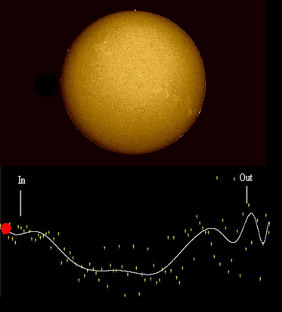

Exoplanets may be detected with amateur telescopes, if they are big enough and if they pass in front of the star they orbit as seen from the Earth. By measuring the light of the star, a decrease in brightness is detected while the exoplanet transits it.
The majority of the exoplanets has until now been detected by the method of radial velocity. This method doesn't allow to determine with precision the planetary mass (and consequently the density), because the angle of the orbital plane is unknown. By this method M sin i is obtained instead of M, where M is the mass of the planet and i is the angle of the orbital plane relative to the line of sight ( i = 0º in polar view, i = 90º in equatorial view). When an exoplanet transit its star, it means that we have an equatorial view of the system, hence i ≈ 90º and consequently M sin i = M.
The detection of exoplanetary transits is very important in order to accurately determine the mass of the planet. For ephemerid and data on exoplanetary transits search Transit Search Organization .
FA and/or JG : Made in collaboration with Filipe Alves and/or João Gregório.